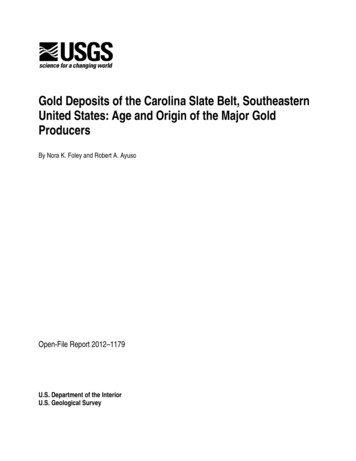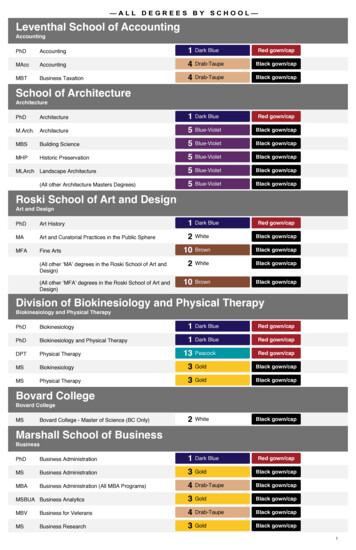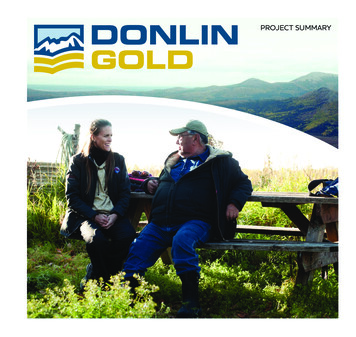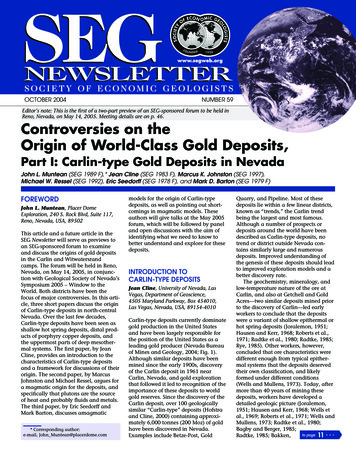
Transcription
Gold Deposits of the Carolina Slate Belt, SoutheasternUnited States: Age and Origin of the Major GoldProducersBy Nora K. Foley and Robert A. AyusoOpen-File Report 2012–1179U.S. Department of the InteriorU.S. Geological Survey
U.S. Department of the InteriorKEN SALAZAR, SecretaryU.S. Geological SurveyMarcia K. McNutt, DirectorU.S. Geological Survey, Reston, Virginia: 2012For more information on the USGS—the Federal source for science about the Earth,its natural and living resources, natural hazards, and the environment—visithttp://www.usgs.gov or call 1–888–ASK–USGSFor an overview of USGS information products, including maps, imagery, and publications,visit http://www.usgs.gov/pubprodTo order this and other USGS information products, visit http://store.usgs.govSuggested citation:Foley, N.K., and Ayuso, R.A., 2012, Gold deposits of the Carolina Slate Belt, southeastern United States—Age andorigin of the major gold producers: U.S. Geological Survey Open-File Report 2012–1179, 26 p.Any use of trade, product, or firm names is for descriptive purposes only and does not implyendorsement by the U.S. Government.Although this report is in the public domain, permission must be secured from the individualcopyright owners to reproduce any copyrighted material contained within this report.
ContentsAbstract . 1Introduction . 2Epithermal Models . 4Geologic Setting . 6Significance of Neoproterozoic Gold Deposits . 9Rocks of Persimmon Fork, Uwharrie, and Tillery Formations . 10Age of the Volcanic Host Rocks and Gold Deposits . 12Mineralogy and Textures of Selected Gold Deposits . 13Fluid Chemistry . 16Sulfur Isotope Data . 17Lead Isotope Data . 18Neodymium Isotope Data . 19Recent Exploration Efforts in the Region . 20Summary . 21References Cited . 22Additional References. .18.Historic open pit of the Haile Gold Mine, South Carolina . 2Gold grades and tonnages for deposit types similar to the Haile and Ridgeway deposits . 3Geologic environments for volcanic-related gold deposits . 4The regional distribution of rocks in the Carolina and Avalonian tectonic zones. 6Terrane distributions in the Carolina zone . 7Stratigraphic correlations of the Carolina terrane. 8Secular variations in gold resources, Carolina Slate Belt . 9Photographs of rocks of the Persimmon Fork and Uwharrie Formations: (1–3) silicified metatuff andtuffaceous siltstone typical of rocks near the gold deposits, (4) tectonic breccia at Haile, (5–6) pyritecemented breccias and silicified and mineralized hydrothermal stockwork in subvolcanic porphyry,(7–8) phyllite and mudstone of the Tillery Formation . 10Plots of tantalum-ytterbium (Ta-Yb) for the Persimmon Fork Formation and regional equivalents . 11Age dating of host rocks and gold deposits of the Carolina Slate Belt . 12Mineralogies and textures of three types of selected gold deposits in the Carolina Slate Belt. 13Evidence in ore textures for the presence of early epithermal gold mineralization . 14Evidence in volcanic rock textures for the presence of early epithermal gold mineralization . 15Fluid inclusion data for the major gold deposits compared to classic datasets for high- andlow-sulfidation (HS, LS) epithermal deposits and gold-rich volcanogenic massive sulfide (VMS)deposits . 16Sulfur isotope data for ore deposits of the Carolina Slate Belt . 17Lead isotope compositions for the gold deposit of the Carolina Slate Belt . 18Neodymium isotope data for host rocks and gold deposits of the Carolina Slate Belt . 19Locations of recent exploration and drilling by companies referred to in the text . 20iii
Tables1.2.The Haile Gold Mine reserve and resource estimates . 3Age and origin of deposits of the Carolina Slate Belt . 21Conversion Factors, Abbreviations and Acronyms, and SymbolsInch/Pound to SIMultiplyByTo obtainVolumeounce, fluid0.02957literSI to Inch/PoundMultiplyByTo obtainLengthkilometer (km)0.6214mile (mi)Massgram (g)0.03527ounce, avoirdupois (oz)megagram (Mg)1.102ton, short (2,000 lb)megagram (Mg)0.9842ton, long (2,240 lb)Temperature in degrees Celsius ( C) may be converted to degrees Fahrenheit ( F) as follows: F (1.8 C) 32Abbreviations and AcronymsAFMAgAsAuCO2CSBCuFeFmGag/tan AFM diagram is a threecomponent triangular graphsilverarsenicgoldcarbon dioxideCarolina Slate Beltcopperironformationgiga annumgross tonKpotassiumppmparts per millionkgMaMgoMoMozNaClNdOsPbkilogrammillion yearsmagnesium oxidemolybdenummillion ouncessodium niumrare earth elementtantalumtelluriumuraniumvolcanic arc granitesvolcanogenic massive sulfideytterbiumzincSymbols approximately less than%ivpercent
Gold Deposits of the Carolina Slate Belt, SoutheasternUnited States: Age and Origin of the Major GoldProducersBy Nora K. Foley and Robert A. AyusoInvited paper for a Special Session on Mining in the United States at the 2012 Prospectors &Developers Association of Canada International Convention, Trade Show & Investors Exchange,Toronto, Canada, March 7, 2012. Numbered figures in this report were originally prepared as slides.AbstractGold- and iron sulfide-bearing deposits of the southeastern United States have distinctivemineralogical and geochemical features that provide a basis for constructing models of ore genesis forexploration and assessment of gold resources. The largest (historic) deposits, in approximate millionounces of gold (Moz Au), include those in the Haile ( 4.2 Moz Au), Ridgeway ( 1.5 Moz Au), Brewer( 0.25 Moz Au), and Barite Hill (0.6 Moz Au) mines. Host rocks are Late Proterozoic to earlyPaleozoic ( 553 million years old) metaigneous and metasedimentary rocks of the Carolina Slate Beltthat share a geologic affinity with the classic Avalonian tectonic zone. The inferred syngenetic andepithermal-subvolcanic quartz-porphyry settings occur stratigraphically between sequences ofmetavolcanic rocks of the Persimmon Fork and Uwharrie Formations and overlying volcanic andepiclastic rocks of the Tillery and Richtex Formations (and regional equivalents). The Carolina SlateBelt is highly prospective for many types of gold ore hosted within quartz-sericite-pyrite alteredvolcanic rocks, juvenile metasedimentary rocks, and in associated shear zones. For example, shearedand deformed auriferous volcanogenic massive sulfide deposits at Barite Hill, South Carolina, and in theGold Hill trend, North Carolina, are hosted primarily by laminated mudstone and felsic volcanic tovolcaniclastic rocks. The high-sulfidation epithermal style of gold mineralization at Brewer and lowsulfidation gold ores of the Champion pit at Haile occur in breccias associated with subvolcanic quartzporphyry and within crystal-rich tuffs, ash flows, and subvolcanic rhyolite. The Ridgeway and Hailedeposits are primarily epithermal replacements and feeder zones within (now) metamorphosed crystalrich tuffs, volcaniclastic sediments, and siltstones originally deposited in a marine volcanic-arc basinalsetting. Recent discoveries in the region include (1) extensions of known deposits, such as at Hailewhere drilling has identified an extensive gold-rich feeder system; and (2) newly discovered prospectslike the porphyry-style gold-copper-molybdenum occurrence reported at Deep River, N.C. Gold ores atRidgeway and Haile represent the low-sulfidation, disseminated, shallow subaqueous tuffaceousequivalents of intrusion-related high-sulfidation ores such as those at Brewer. Haile also hasmineralogical features that support a stockwork disseminated model of pyrite-gold-sericitemineralization in which a significant amount of ore was deposited in sediments at or near the surface.The potential is high for gold-rich ore at depth in the funnel-shaped feeder zones that likely underliesuch surface variants of high sulfidation–low sulfidation epithermal systems and for new discoveries ofsimilar deposits in areas undercover. Exploration strategies for large-scale gold-mineralizing systems1
applied to rocks of the Carolina Slate Belt, and by extension, the Carolinian-Avalonian tectonic zone ofNorth America, benefit from applying subvolcanic and basinal epithermal models for goldmineralization.IntroductionToday I am going to talk about the age and origin of Neoproterozoic gold deposits that occurwithin the Carolina Slate Belt (Slate Belt) in the southeastern United States. This presentation includesan up-to-date summary of the results of studies conducted in the region by a U.S. Geological Surveygroup led by Robert A. Ayuso. The group included Sandra H.B. Clark, Nora K. Foley, Terry L. Klein,Terry W. Offield, and Robert R. Seal.Haile Gold Mine, South CarolinaFigure 1.Historic open pit of the Haile Gold Mine, South Carolina.The photograph shown in figure 1 was taken about 1998, and it shows the open pit of the Hailedeposit of Lancaster County, South Carolina, which produced approximately 50 metric tons of gold.New and more recent drilling by Romarco Minerals Inc. has delineated an additional 115 metric tonsof gold (Au), bringing the estimate of the amount of contained gold in this one Slate Belt gold deposit towell over 160 metric tons ( 5.6 million ounces of gold, table 1). This morning I am going to summarize2
some of the major ideas with respect to the age and evolution of the rocks that host the largest of thegold deposits and the range of mineralization styles and deposit models that are now being applied toexploration and assessment activities related to the gold resources in the region.Table 1. The Haile Gold Mine reserve and resource estimates.[Accessed March 13, 2012, Overview/default.aspx]TonnageGradeResource(million tonnes)(grams/tonne)Measured and Indicated71.21.77Total gold(ounces)4,000,000Inferred20.11.24800,000Proven and Probable30.52.062,000,000Gold grades and tonnages What distinguishes Haile and Ridgeway? How much Au remains in the Carolinas?Figure 2.Gold grades and tonnages for deposit types similar to the Haile and Ridgeway deposits.The Carolina Slate Belt is part of a package of rocks that extends from Alabama to Virginia andcontains over 1,500 documented occurrences of gold. On figure 2, which shows grade versus tonnage,we have plotted produced gold for a number of Carolina Slate Belt gold deposits in comparison withpublished data sets for VMS (volcanogenic massive sulfide) deposits in blue squares (Galley and others,3
2007), shear-zone gold deposits in green circles (Mutschler and Mooney, 1993), and some epithermaltype deposits in orange (Heald and others, 1987). With gold projected by some commodity analysts toexceed 1,800/ounce by the end of 2012, and with a focus on job and economic challenges in theUnited States, some questions worth revisiting examine what distinguishes the larger deposits at Haileand Ridgeway from other gold occurrences in the region and what the potential is for additionaldiscoveries of large gold resources in the Slate Belt.Historically, the Slate Belt deposits have produced gold ranging from about 1 metric ton fromsmall operations to well over 50 metric tons. The wide range in the size of the Slate Belt gold deposits isdue, in part, to the fact that historic producers include small Au-VMS deposits like Barite Hill insouthern South Carolina (Clark and others, 2000; Seal and others, 2001) and shear-zone-hostedorogenic-style deposits like those at the Howie mine, Union County, North Carolina (Foley,unpublished data, 2012). In contrast, the larger gold deposits—such as those at Haile and Ridgeway incentral South Carolina—are generally now thought to belong to the epithermal class (Foley and others,2007). For many years their origin was controversial because of their age and complex history ofdeformation and metamorphism. The data presented here support an epithermal origin for the largestdeposits.Epithermal ModelsGold in epithermal depositsFigure 3.Geologic environments for volcanic-related gold deposits.4
Figure 3 shows a continuum of geologic environments for volcanic-related gold deposits formedin submarine-to-subaerial and volcanic-to-plutonic settings. These include, from left to right, shallowlyemplaced high-sulfidation copper-gold epithermal systems, such as are found at the Brewer mine incentral South Carolina, which produced approximately 5 metric tons of gold; low-sulfidation epithermalsystems, such as are found at Ridgeway and Haile, which both produced in the range of 50 metric tonsof gold; and also gold-rich volcanogenic massive sulfide systems, such as the auriferous base-metalsulfide-rich ores at the Barite Hill deposit, which produced about 2 metric tons of gold. Somenoteworthy studies relating to the genesis of gold deposits of the Carolina Slate belt include these:Worthington and Kiff (1970), Feiss and others (1993), Gillon and others (1995,1998), Maddry andKilbey (1995), Zwaschka and Scheetz (1995), Clark and others (2000), Seal and others (2001), Foleyand others (2001), Ayuso and others (2005), Foley and others (2007), and Klein and others (2007).Most modern thinking on epithermal deposits, especially those having a high sulfidationsignature, considers that deep porphyry copper gold systems constitute the magmatic roots of shallowepithermal gold systems (for example, Sillitoe and Hedenquist, 2003). With respect to the Slate Belt, acritical question is how closely are these epithermal deposits linked to deep porphyry systems: Do thesedeposits, in fact, have porphyry roots? Or has, for example, extensional tectonism in the form of largescale crustal faulting and uplift (as described by Tosdal and others, 2009) resulted in near-surfacemagmatic-hydrothermal gold systems without roots?5
Geologic SettingCarolina/Avalon tectoniczones?Figure 4. The regional distribution of rocks in the Carolina and Avalonian tectonic zones. Modified from Hibbardand others (2002) and Hibbard and others (2005).Taking a step back, the map in figure 4 shows the regional distribution of rocks in the Carolinaand Avalonian tectonic zones; the Carolina zone, shown in blue, hosts the gold deposits of the SlateBelt. The Carolina terrane has long been considered by many to be a southern extension of the Avalonterrane (Shervais and others, 1996; Dennis and Wright, 1997; Dennis and others, 2004; Hibbard andothers, 2002, 2005; Murphy and others, 1999), which also contains large epithermal deposits—forexample, the Hope Brook deposit, Newfoundland, Canada (Dubè and others, 1998), which reportedlycontains more than 45 metric tons of gold. Others now consider the Carolina terrane as a separate,independent crustal block that records a much longer tectono-thermal history with arc magmatismextending well into the Cambrian period (Hibbard and others, 2007, 2010; Pollock and Hibbard, 2009;Pollock and others, 2010). These studies establish that the Carolina zone is a remnant of a volcanic arcand that the major gold deposits likely formed in an arc-rift to back-arc basin setting on the margin ofwest Gondwana. The Carolina terrane was accreted to the eastern Laurentian margin probably in theMiddle to Late Ordovician age (Hibbard and others, 2003).6
Terrane distributions in the CarolinaZone7Figure 5. Terrane distributions in the Carolina zone. Modified from Hibbard and others (2002) and Hibbard andothers (2005).The three rock sequences that make up the Carolina zone (Hibbard and others, 2002, 2005) areshown on figure 5 in shades of green. The sequences consist mainly of Late Proterozoic to Cambrianmetavolcanic rocks and associated epizonal plutons. The oldest is the Virgilina sequence, which isfound mostly in North Carolina; the middle Cary sequence is restricted to a sliver of Georgia. TheAlbemarle sequence, which extends from Georgia to North Carolina, is the youngest, and it contains theunits that host most of the known gold deposits and most of the new discoveries. These include theChampion Hills trend, North Carolina (location 2 on fig. 5); the Brewer mine, South Carolina (3); theMidway target, South Carolina (4); the Haile deposits and extension, South Carolina (5); the Ridgewaydeposits, South Carolina (6); and the Barite Hill deposit, southern South Carolina (7). An interestingexception is the Deep River prospect, North Carolina (1), which is sited in rocks of the older Virgilinasequence but is apparently much younger in age (Rapprecht and others, 2010).The sequences of the Carolina zone are bounded by shear zones of the Late Paleozoic age. Theseare the Modoc Shear zone to the southwest, the Nutbush Creek shear zone to the northeast, and theGold Hill fault zone (Hibbard and others, 2003), which forms the contact of the Carolina Slate Belt withthe Charlotte zone to the west. The Gold Hill fault zone contains numerous small shear-zone-hostedorogenic-style gold deposits (in the range of less than 5 metric tons).7
One last point to make is that a large extent of the eastern margin of the Albemarle sequence, inparticular, is covered by onlapping sediments of the Atlantic Coastal Plain. These sediments run right upagainst the gold deposits in the vicinity of Haile and Brewer.Carolina Terrane stratigraphiccorrelationsFigure 6.Stratigraphic correlations of the Carolina terrane.Figure 6 shows stratigraphic correlations of the Carolina terrane from south to north and some ofthe available age dates. The main volcanic host for much of the gold mineralization is the PersimmonFork Formation as defined in east-central South Carolina, which is correlative with the Uwharrieformation in North Carolina, and felsic metatuff near the Georgia–South Carolina state line. The knowndeposits are generally all located at or near the upper contact of the Persimmon Fork and UwharrieFormations with overlying mudstones, siltstones, and mafic volcanic rocks of the Tillery and RichtexFormations. The Tillery and Richtex Formations and regional equivalents are generally undated but arethought to be older than Ordovician. Thus, the gold mineralization is bracketed by regional geology tothe late Neopropertozoic.8
Significance of Neoproterozoic Gold DepositsSecular variation in Au resources Carolina terrane, CSB locally preserved shallowlevel remnant ofNeoproterozoic ‘Gondwana’ Contains some the oldestknown epithermal-Au Distinctive character Au-Cu-Ag-Mo-Pb-As-Te,REE signaturesFe-oxide /sulfide breccias,layers, mineralogyhydrothermal alterationassemblages and stylesFigure 7. Secular variations in gold resources, Carolina Slate Belt (Groves and others, 2005; Goldfarb andothers, 2010).Figure 7 shows a figure from the literature describing secular variations in gold resources forthree types of gold deposits: porphyry Cu-Au, epithermal Au-Ag, and orogenic Au. We’ll focus on thedata for epithermal deposits. I have added the age of the Slate Belt, shown with the gold star. TheCarolina Slate Belt contains some of the oldest known epithermal deposits in the world. In general,these Neoproterozic epithermal gold deposits have important differences relative to, for example, themuch younger, circum-Pacific type epithermal gold deposits and those occurring throughout the westernUnited States (for example, John, 2001). These differences include a distinctive geochemicalfingerprint, which includes Au, Cu, Ag, Mo, Pb, As, Te, and REE; the presence of Fe-sulfide and Feoxide breccias, layers, and stockwork veining; and also distinctive hydrothermal alteration styles.9
Rocks of Persimmon Fork, Uwharrie, and Tillery FormationsPersimmon Fork, Uwharrie14732658Figure 8. Photographs of rocks of the Persimmon Fork and Uwharrie Formations: (1–3) silicified metatuff andtuffaceous siltstone typical of rocks near the gold deposits, (4) tectonic breccia at Haile, (5–6) pyrite cementedbreccias and silicified and mineralized hydrothermal stockwork in subvolcanic porphyry, (7–8) phyllite andmudstone of the Tillery Formation. An AFM diagram of Persimmon Form Formation shows a generally calc-alkalinetrend.The top row of figure 8 shows photographs of silicified metatuff and tuffaceous siltstone typicalof the Persimmon Fork and Uwharrie Formations near the gold deposits at Haile, Ridgeway, andBrewer. The second row shows a tectonic breccia at Haile and pyrite cemented breccias and silicifiedand mineralized hydrothermal stockwork in subvolcanic porphyry at Brewer. The bottom row showsphyllite from the Gold Hill shear zone and a photograph of mudstone of the Tillery Formation. (Allphotographs by N.K. Foley, unpublished data, 2012.) As these photographs show, the types of rocks thatcomprise the ore hosts vary widely; the Persimmon Fork and Uwharrie Formations include felsicvolcaniclastic rocks and mudstones, rhyolitic ashflows, crystal tuffs, and subvolcanic and plutonicintrusives. The overlying Richtex and Tillery Formations are composed of turbiditic metamudstones,metawacke, and interlayered mafic metavolcanics. All of the rocks are extensively deformed,metamorphosed, and saprolitically altered.10
Trace element geochemistry Host rocks Barite Hill, S.C.: Felsicvolcanics, LincolntonmetadaciteHaile, S.C.: Felsic volcanic andvolcaniclastic tuffs of thePersimmon Fork FmGold Hill Fault, Albemarle,Howie, Reed, Russell,Champion Hills, N.C.: felsicvolcanic and volcaniclastic tuffsof the Uwharrie Fm Trends consistent withvolcanic arc relatedsignatures (VAG)Figure 9.Plots of tantalum-ytterbium (Ta-Yb) for the Persimmon Fork Formation and regional equivalents.These complexities make stratigraphic correlations in the region difficult, but the consensus isthat the bulk of the rocks collectively represent a long-lived, mature arc system. An AFM diagram(fig. 8) shows that the Persimmon Fork is consistent with the expected calc-alkaline trend (Ayuso andothers, 2005). Other trace element distributions (fig. 9) are also consistent with volcanic arc relatedsignatures. For example, plots of Ta-Yb show that the composition of the Persimmon Fork Formation atHaile, correlative felsic volcanic rocks at Barite Hill, and volcanic rocks of the Uwharrie in NorthCarolina are also consistent with volcanic arc related signatures (Ayuso and others, 2005; Glascock andSpeakman, 2005).11
Age of the Volcanic Host Rocks and Gold DepositsAges: host rocks & gold deposits Re-Os on565555molybdenite238U/206PbAge (Ma)545535 Topaz565555Moly545 U-Pb on zircon 535570560Stein and others (1996)Haile: 554 3 MaRidgeway: 552 3, 558 3MaAyuso and others (2005)Brewer 550 3 MaHaile 553 MaRidgeway 556 3 Ma550540Ayuso and others (2005)Figure 10.Age dating of host rocks and gold deposits of the Carolina Slate Belt.There have been numerous attempts to date both the deposits and the immediate host rocks byusing various techniques. The successful ones are Re-Os on molybdenite and U-Pb ion probe orSHRIMP data on zircon (fig. 10). The studies we completed on zircons at Haile, Ridgeway, and Brewerare especially useful because we were able to both date the host rocks and provide a link with thehydrothermal event that resulted in gold mineralization by looking closely at the zircon populations(Ayuso and others, 2005). What is interesting is that the zircon populations analyzed showimperfections that indicate hydrothermal etching or recrystallization related to early stages ofmineralization. For example, the age of subvolcanic intrusive at Brewer is 550 Ma. At Brewer, zircon isencrusted and replaced by topaz that formed during an early alteration stage associated with goldmineralization. Likewise, at Haile the age of the volcanic host is 553 Ma. The pits and cavities in zirconfrom Haile contain muscovite flakes and small crystals of molybdenite that are prominent in thealteration and mineral assemblages, so we think that the zircon crystallization ages are closely linked toearly stages of mineralization. These zircon ages line up well with Re-Os ages on molybdenite from theHaile and Ridgeway deposits as measured by Stein and others (1996).New age-information on subvolcanic-intrusion-related mineralization near Deep River, N.C.,(Rapprecht, 2010) also supports an age of 550 Ma for felsic dikes that cut rocks of the Virgilina12
sequence and are thought to be equivalent to rocks of the Uwharrie Formation. Molybdenite (Rapprechtand others, 2010) from the Deep River prospect is dated at 543 Ma and 532 Ma, suggesting a younger,Cambrian-age, mineralizing event.Mineralogy and Textures of Selected Gold DepositsMinerals & TexturesAuBrewer-HSHowieCu-AuOrogenic AuFigure 11.Haile and RidgewayLS Epi-AuMineralogies and textures of three types of selected gold deposits in the Carolina Slate Belt.Figure 11 shows the distinctive mineralogies and textures of three types of gold deposits in theSlate Belt: shear-zone hosted orogenic-style mineralization, high sulfidation (HS) epithermal goldmineralization, and low sulfidation (LS) epithermal gold mineralization.Gold deposits occurring along late Ordovician shear zones, which are related to docking of theCarolina terrane to the Charlotte terrane and accretion of the Carolina zone to the eastern margin ofLaurentia, include the Howie mine, North Carolina (fig. 11, left column). In these deposits, the sulfidesand quartz are recrystallized and gold is associated with massive quartz veins containing pyrrhotite andpyrite and other base metal sulfides, including arsenopyrite (N.K. Foley, unpublished data, 2012).In contrast, high-sulfidation epithermal gold deposits of the Slate Belt, of which Brewer may bea unique example, can be expected to have a classic enargite-pyrite-chalcopyrite-gold assemblage(fig. 11, center column) (Foley and others, 2007). Minor covellite is also present. The alterationassemblages, including andalusite, topaz, and pyrophyllite, are consistent with those expected for highsulfidation acid-sulfate-style systems. The sulfides form in structure-controlled massive veins and ascements for sulfide breccias. As shown in the thin section photograph, the sulfide minerals are coarser13
grained, more equant, and intergrown compared to textures for the other epithermal gold deposits. Thesulfide minerals of the high-sulfidation system at Brewer are really texturally quite distinct from thefiner grained, almost sedimentary-style bedded and layered textures that characterize the large lowsulfidation epithermal-gold deposits that are found nearby at Haile and Ridgeway (fig. 11, right panel).At Haile and at Ridgeway, gold is associated with both quartz and pyrite. Pyrite dominates the sulfidemineralogy and only very mino
Gold Deposits of the Carolina Slate Belt, Southeastern United States: Age and Origin of the Major Gold Producers . By Nora K. Foley and Robert A. Ayuso . Open-File Report 2012-1179 . . Union County, North Carolina (Foley, unpublished data, 2012). In contrast, the larger gold deposits—such as those at Haile and Ridgeway in










